

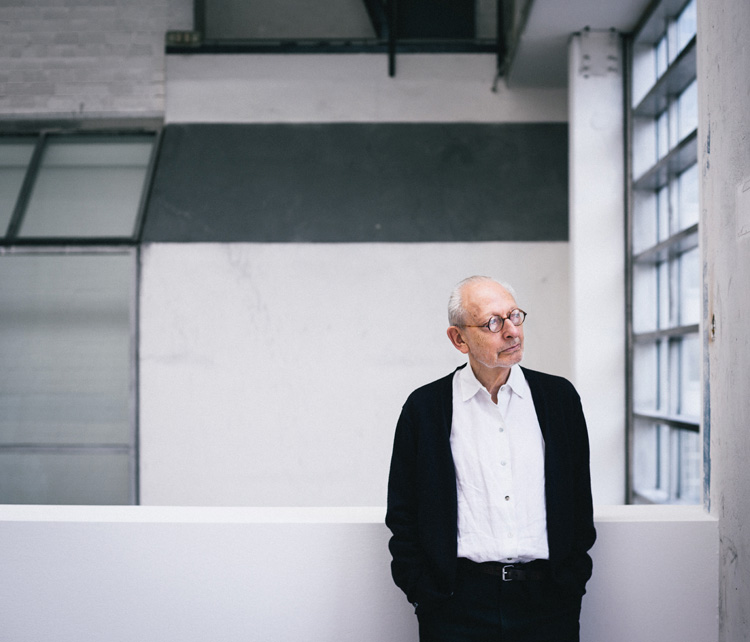
Michael Simpson. Photo: Wolfgang Starr.
by DAVID TRIGG
Michael Simpson (b1940, Dorset) has been making paintings for more than 60 years. Unlike his Royal College of Art contemporaries David Hockney and Patrick Caulfield, the British artist spent many years at the periphery of the art world, eschewing trends in favour of pursuing a highly personal vision. Working from a former gasworks in Bradford-on-Avon in Wiltshire, he paints almost daily, dedicating himself to what he describes as “the mechanics of painting”. His canvases, which for 30 years have addressed “the infamy of religious history”, are large and austere; characterised by a restrained palette, they drip with references to 15th-century Venetian and early Flemish painting, minimalism and brutalism.
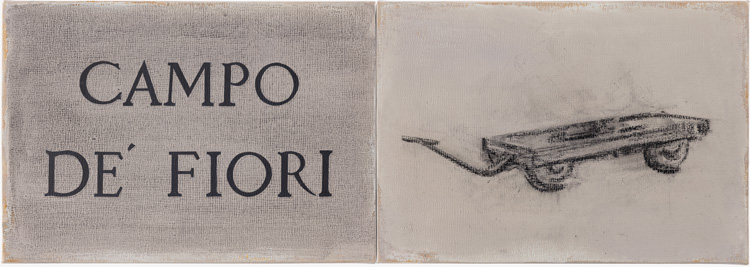
Michael Simpson. 17 February 1600, 2019. Oil and charcoal on canvas, 35 x 100 cm. Images courtesy the artist and Blain|Southern.
Simpson’s antipathy towards organised religion, and specifically Catholicism, informs all his work. Between 1989 and 2009, he focused exclusively on a series of monumental canvases entitled Bench Paintings. These were intended as a homage to Giordano Bruno (1548-1600), an Italian Dominican friar known for his cosmological beliefs who, after enduring eight years of interrogation and torture by the Catholic Inquisition, was burnt at the stake for heresy. More recently, Simpson has been making highly stylised paintings of leper squints – small apertures built into the exterior walls of medieval churches through which, it is believed, lepers and other undesirables were allowed to observe the service from outside. Informed by this architectural legacy of exclusion, Simpson’s Squint paintings feature small, black squares or rectangles towards the top of each canvas; these mysterious holes are accompanied by various ladders or steps – a mocking invitation to ascend and peer into the void.
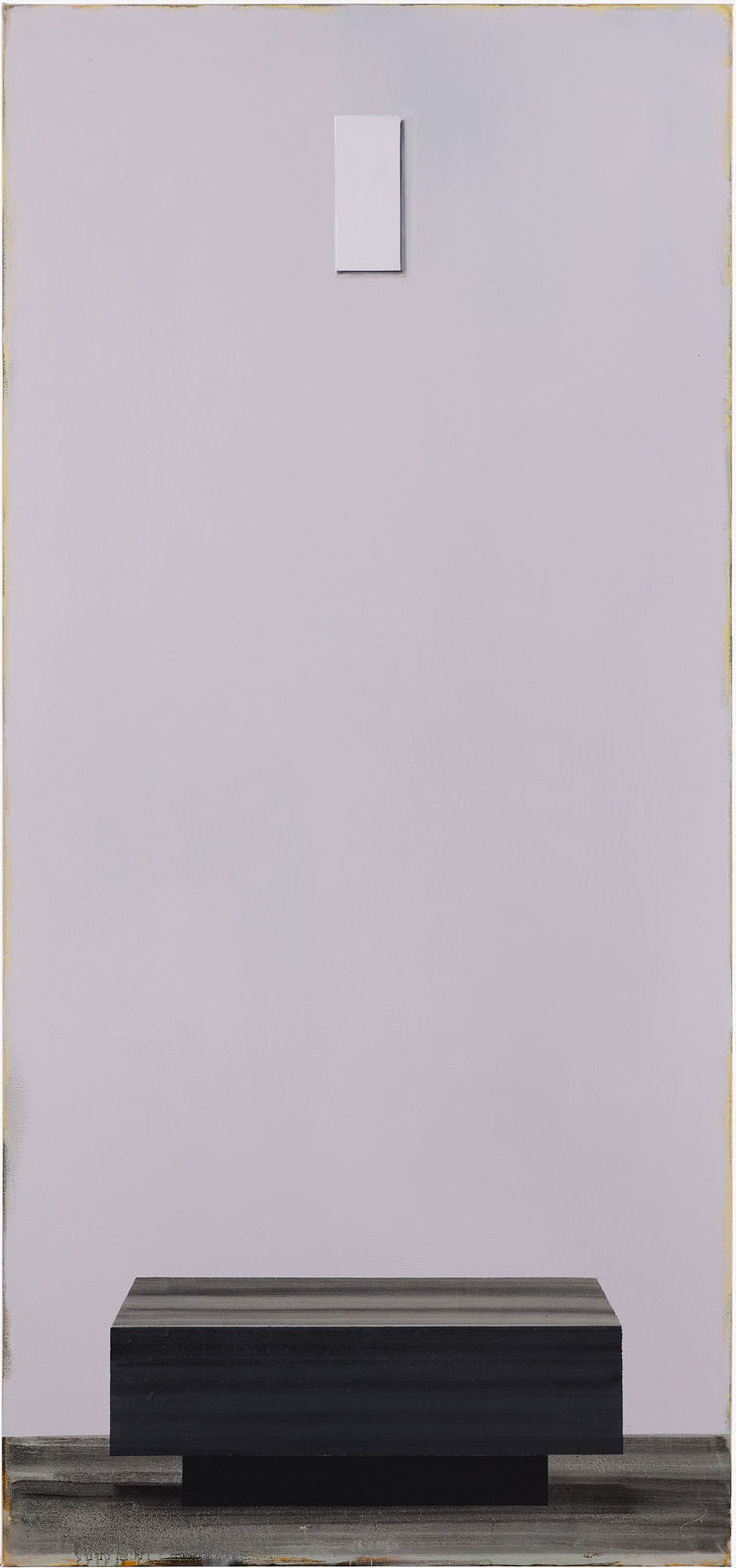
Michael Simpson. Squint 64, 2019. Oil on canvas, 230 x 107.5 cm. Images courtesy the artist and Blain|Southern.
In 2016, following his largest exhibition to date at Spike Island, Bristol, Simpson’s relentless commitment to painting won him the prestigious John Moores Painting Prize. His latest exhibition at Blain Southern, London, presents a significant body of new work, including several large-scale Squint paintings, Confessional paintings and even a couple of new, small Bench Paintings.
In this interview, he discusses his formative experiences as a painter, his attitude towards organised religion and his rigorous approach to the making of paintings.
David Trigg: What first brought you to painting?
Michael Simpson: I started making paintings when I was seven years old. In 1947, my uncle took me to a football match; we climbed to the top of the terraces and I still have a vivid memory of the experience because what I saw were coloured fragments moving around and on top of a green rectangle. Although I didn’t understand the word aesthetics, I knew I was profoundly moved by the sensation of colour. My mother told me years later that, for several months afterwards, I would sit on the carpet spending hours arranging coloured objects in various ways. That’s when I started, in a very naive way, to paint.
.jpg)
Michael Simpson, New Paintings, 2019. Installation view, Blain|Southern London. Photo: Peter Mallet.
DT: When did you first encounter modern art?
MS: When I was about 11 or 12, on a visit to the dentist. Thumbing through the magazines in the waiting room, I found an article on Balthus with a reproduction of Thérèse Dreaming (1938). I tore the page out, took it home and pinned it to the wall. This was the first reproduction of a painting I could feed off; when I was growing up, there wasn’t even a book in the house. At 16, I started travelling up to London from Dorset to visit the National Gallery and the Tate at Millbank. I just immersed myself and it was from about this time that I began to experiment seriously with oil paint.
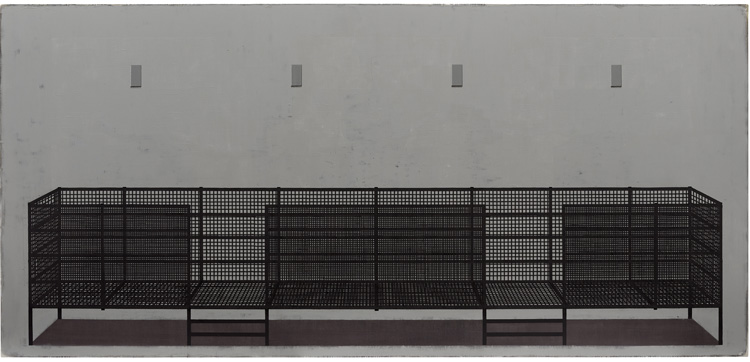
Michael Simpson. Squint 62, 2018-19. Oil on canvas, 244 x 517.5 cm. Images courtesy the artist and Blain|Southern.
DT: You have described the central theme of your work as the “infamy of religious history”. As an avowed atheist, to what do you attribute your enduring interest in religion?
MS: Before I answer that, I want to say that what I’m interested in essentially is painting; I’m interested in the history of painting, the mechanics of how paintings are actually built, how they’re made. The infamy of religious history plays only a minor role. Going back to your question, I believe we’re really an infant species, still essentially primitive, and nothing reveals our stupidity as much as religion. That’s why, for me, it’s a really profound subject. I had a kind of curious upbringing. My mother was a Russian Jew; I was bar mitzvahed when I was 13, dragged along to the synagogue and made to sing in the choir. I hated it. I came to the conclusion very quickly that God didn’t exist and that we were all fooling ourselves. When I was about 16 or 17, I read Percy Shelley’s book The Necessity of Atheism, and that left a big impression on me. A couple of years later, on my second trip to Russia, in Odessa, I found Giordano Bruno’s book The Ash Wednesday Supper, in which five people sit and discuss the Copernican theory. I knew nothing about Bruno at all, so when I came back to England I searched out everything I could possibly find by and on him. I didn’t begin the Bench Paintings until years later, but Bruno was there all the time in the back of my mind, with the idea of making some kind of homage.
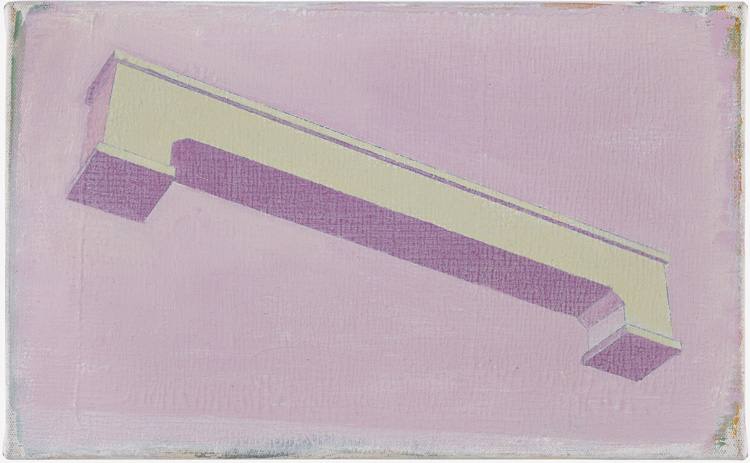
Michael Simpson. Untitled (Bench Painting), 2019. Oil on canvas, 32 x 20 cm. Images courtesy the artist and Blain|Southern.
DT: The Squint paintings exemplify your engagement with religious history. How did you come to that subject?
MS: From my early teenage years, I was thinking about the history of religion and all the things that I detest about its practice. Many years ago, when I was a young student, I found a church with a squint in it – St Aldhelm’s, a small Dorset church in Studland. I didn’t actually understand what it could be, but I knew it was interesting and that it had some kind of significance, so I researched it and discovered what it was. As with the benches, I put the idea aside for many years until I had begun to form a language that I could work with. I’d spent a long time, 20 years or so, in Wiltshire with little interest expressed in my work, except by David Risley, who had shown four of the Bench Paintings at his Vyner Street gallery in Bethnal Green, east London. Afterwards, when the Bench Paintings series came to an end, David came down to the studio to talk about a proposed drawing show. He was looking at a couple of drawings I’d made with squints, and said: “You could make paintings of those.” I thought: “He’s right.” So I began the Squint works in June 2012.
DT: The medieval squint was designed to be easily accessed, whereas your apertures appear deliberately difficult to reach – each one requires an ascent, and the steps, the ladders, the apparatus that are required to the reach them seem very precarious or arduous.
MS: And cruel, too; cruel and comedic. And that is, in a sense, one of the critical points – that this aperture is made difficult to reach; the criminality of privilege. And when you do reach the hole, there still exists the unreachable field of Elysium. Incidentally, antiquarian speculation has it that many of these original squints were shuttered.
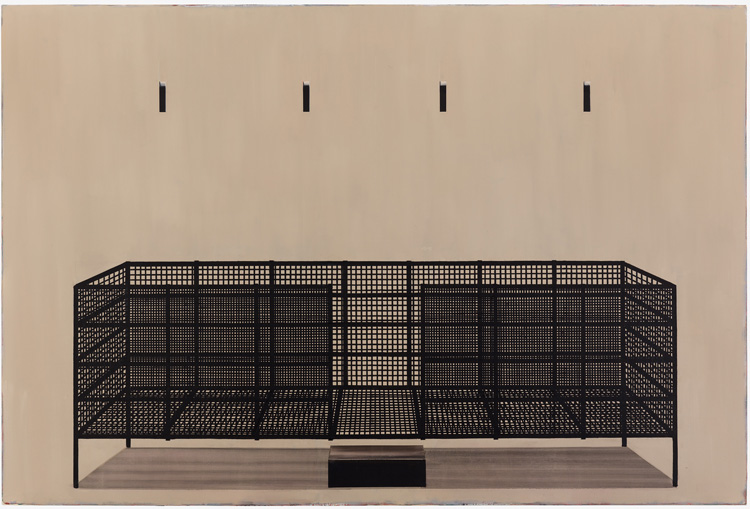
Michael Simpson. Squint 63, 2019. Oil on canvas, 245 x 366.5 cm. Images courtesy the artist and Blain|Southern.
DT: Hence the shutters that you include in some of the paintings?
MS: Exactly, yes. I think it adds a greater austerity to the works. But I find the whole idea so grotesque, that the very people who should ask for help are the ones denied the sanctuary of the building. Of course, we shouldn’t forget that medieval Christians believed that leprosy was a punishment from God, a metaphor for sin.
DT: The medieval squint has certainly been considered a sign of exclusion and prejudice, but Jennifer Sliwka, writing in the exhibition catalogue, suggests that squints are also “markers of inclusiveness” due to the fact that they allowed those on the outside to witness the most sacred part of the Mass – the elevation of the Host – at a time when it was believed that to have seen an object equated to having touched it. So there is a tension between exclusion and inclusion that seems to be echoed in your paintings.
MS: Yes, a crucial element of the whole agony of this aperture.
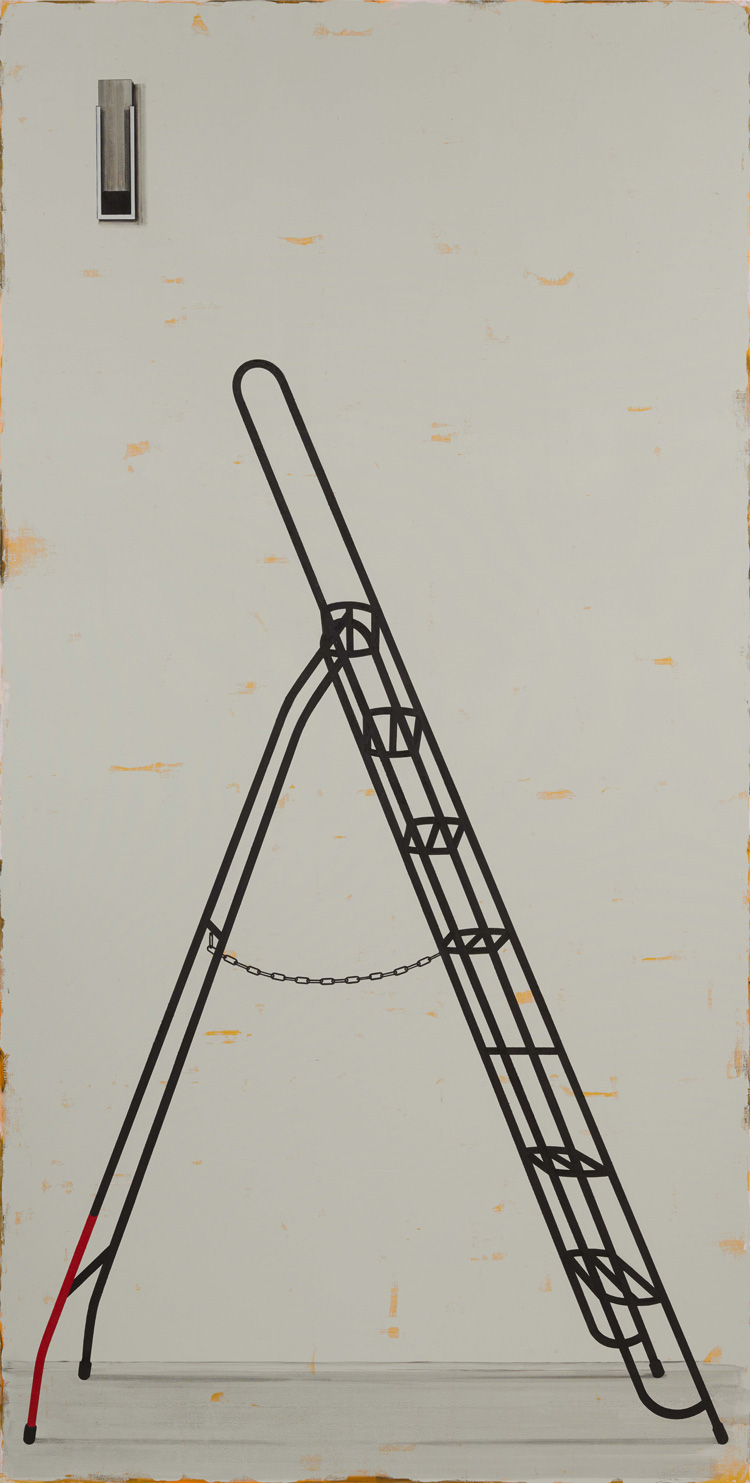
Michael Simpson. Squint 45, 2016-19. Oil on canvas, 427 x 213 cm. Images courtesy the artist and Blain|Southern.
DT: You underscore that sense of agony with the placement of the objects that appear in the paintings. For instance, if you were to ascend the red-legged stepladder in Squint 45, it would take you to a rather inconvenient off-centred position, which, to my mind, would frustrate any attempt to peer through the aperture.
MS: That ladder seemed to present all kinds of sinister possibilities. It is such an unusual ladder, almost like a skeleton of a ladder. It seemed a great object to use because I’m interested in the absurdity of ascension in religious mythology. It’s about the idea of a person being relegated to a position of utter wretchedness in relation to such power. And so there’s a subjective underlining of that idea. But these elements that we’re talking about are subjective – painting contains its own truths. For me, what is paramount is that the paintings work on a formal level.
.jpg)
Michael Simpson, New Paintings, 2019. Installation view, Blain|Southern London. Photo: Peter Mallet.
DT: Do you ever imagine the space that lies beyond one of your squints?
MS: All the time! We exist, all of us, in an infinite space and that for me is the bewilderment of being alive. The hole isn’t just a squint, it’s a great metaphor for my own bewilderment of the world around me. I see this aperture as a hole into infinity and it is very, very disturbing. I think Fontana was interested in the same kind of idea; he wasn’t just interested in the slash but also in what lies beyond.
DT: I was surprised to see some new, smaller Bench Paintings in this exhibition. I was under the impression that you had completed the series.
MS: So was I! But there was one Bench planned for the series that I never began. One afternoon quite recently, I thought of making two variants of the idea on a very small scale, with a couple of canvases lying around the studio. I used an entirely different palette with a much higher key, unlike anything I had used on the larger works. They seemed to work, and that’s why they are in the show.
DT: Working on this smaller scale is unusual for you; most of your paintings are enormous. It’s interesting to hear you say that you had those two small canvases in your studio because I don’t associate that scale with your work.
MS: The size of the stretcher is determined by the nature of the idea. I don’t make big paintings for the sake of making a big splash. But the size, the proportions of the canvas, are crucial, even down to 5cm on a stretcher that’s 400cm long. It’s important for me that the viewer can feel to a certain extent the possibility of being able to step in to the painting and, in a kind of illusory way, take part in a quasi-experience of actually climbing the steps, climbing the ladder and so on.
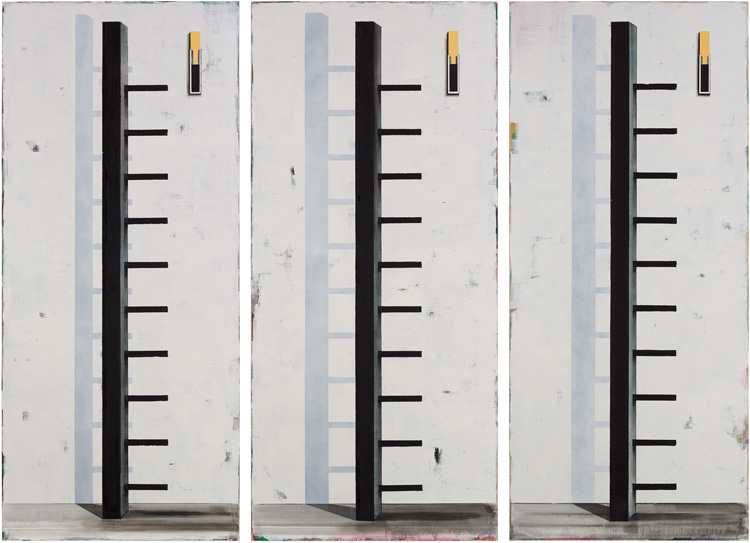
Michael Simpson. Squint 65, 2019. Oil on canvas, 312 x 440 cm. Images courtesy the artist and Blain|Southern.
DT: Some of them are larger than life, while others seem slightly smaller than life.
MS: Yes, but again it’s in relation to the idea. There’s a diptych in the second room of the exhibition [Squint 69 (2019)], which is a variant of the triptych in the first room [Squint 65 (2019)], on a smaller scale. The reason I made that diptych was because I wanted to experiment with changing just a small element. On the left side of the ladder is a low prong, a rung that sticks out in the opposite direction. I knew instinctively that, with that addition, it would work on a much smaller scale.
DT: How do you begin a new work? Do you make many preparatory drawings?
MS: Ideas germinate for a long time, and they invariably come to fruition through the act of drawing, and I do make many drawings, many of which are simply speculative. Every single painting involves an element of fear. I feel the weight of historical painting. I fight it, I battle it all the time, and this may sound odd, but it’s a bit like chess. With chess, you can play the game, but you can only reach a certain level and you can’t go any further. And that’s often how I feel about painting. I’m not going to be a Vermeer, or a Petrus Christus, or a Pollock, so there’s this constant struggle with one’s own belief in the painting itself. But once it gets underway, then ensues the struggle to make it work, to give it a coherency and a real place in the world where it is convincing and contains its own truths.
.jpg)
Michael Simpson, New Paintings, 2019. Installation view, Blain|Southern London. Photo: Peter Mallet.
DT: You once said: “There’s nothing quite like painting to underline your own inadequacy.”
MS: Yes. I find painting extremely difficult. Each painting is a struggle in that strange world of silence that inhabits the practice. I regard a strike rate of three out of 10 paintings that work as successful. As I was saying before, each painting involves an element of fear. There’s something in me that desires to find an absolute, to make the painting really stand up and take on a presence. Most of the time, I am battling this sense of not quite being strong enough to make it happen. I was talking to my assistant, Jack, the other day and we realised that, in addition to the 13 paintings I’ve made for this show, there are another 15 to 20 that could have been used. But most of those are abandoned paintings. In my mind, they represent failure.
DT: What factors lead you to abandon a work?
MS: A great many reasons: the overall value of the colour; the incoherency of the forms; when nothing actually happens between the subject and the aesthetic of the painting, when they don’t touch each other. All these are reasons to abandon a painting. Sometimes I begin a painting, I work on it, maybe for quite a long time, and then I realise it’s just never going to work. I am working with hazardous, subjective references that somehow have to be, not disguised exactly, but left to evaporate and become an innate, integral part of the painting. Between 1989 and 2009, I made just under 80 Bench Paintings and I know that I destroyed about half. Abandonment, failure, paintings destroyed, are all built into the practice; learning of course, also.
DT: When you say destroyed, do you mean you painted over them or are you talking about physical destruction?
MS: Some of them were physically destroyed – cut out of the stretchers. Others were painted over. There are five paintings in this exhibition that actually have finished paintings underneath them, paintings that have been brought to a complete conclusion, which I have then abandoned. The two paintings that have proved the most problematic in this show are the two confessionals. I’ve wanted to make confessional paintings for some time. I’ve worked with pulpits, minbars, leper squints and, of course, the homage to Bruno, the benches. Confessionals are such a grotesque invention of the Catholic church that it seemed to me to be compelling and yet dangerous because the subject is so loaded. I’ve only made five or six confessional paintings and I’m still not quite sure about them. I made a couple of other confessionals, which were shown at Spike Island in 2016; they were far more explicit, but I’m looking for something that is more oblique.
DT: They had curtains, whereas the new ones have screens.
MS: Yes, and a chair. But, as I say, I want to approach the confessional more obliquely, and yet at the same time give some sense of what this hideous invention was about: the idea of an enclosed, dark space with a chair that seats a figure. In some respects, I think the new confessionals work, but the viewer has to work hard to understand what’s going on. It’s possible that they might find some ambiguity in the image.
DT: Some might not even know what a confessional is.
MS: Most people don’t even know what a leper squint is. I think of confessionals as having a kind of human impoverishment. They reveal one of the lowest points of human culture.
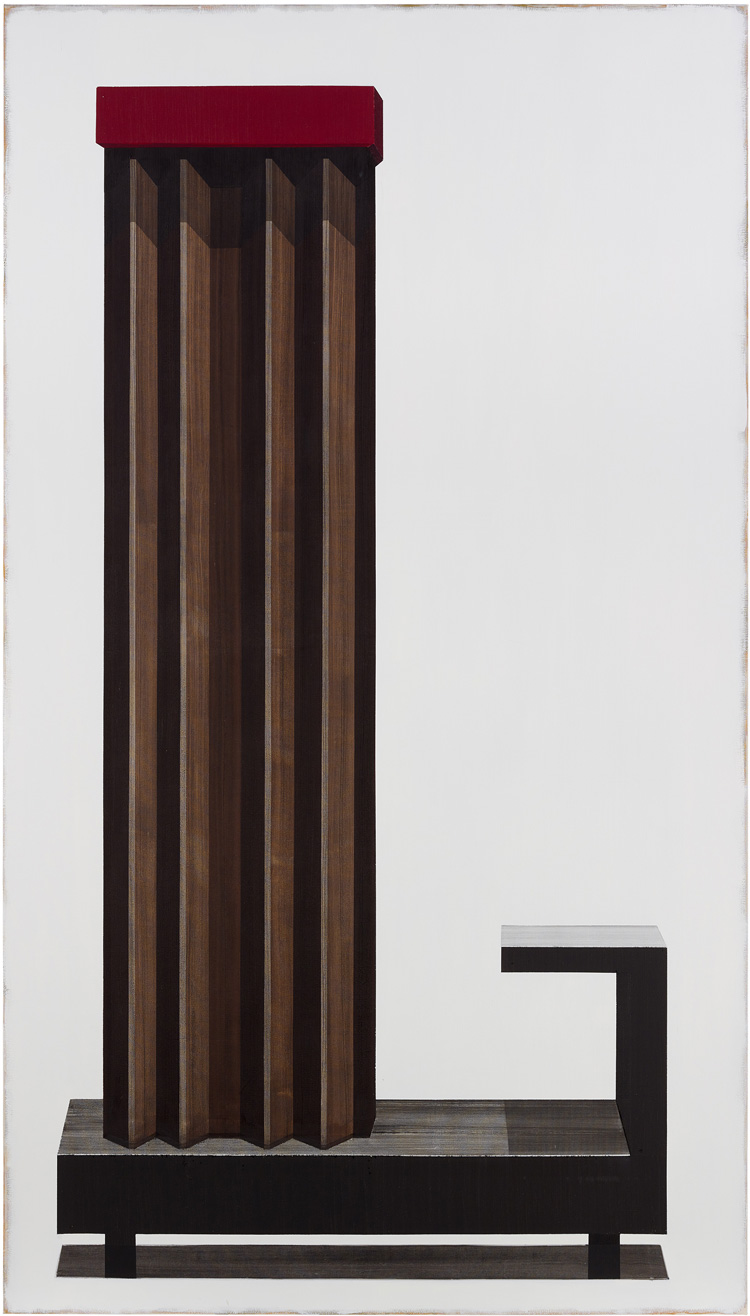
Michael Simpson. Confessional 5, 2018-19. Oil on canvas, 282 x 162 cm. Images courtesy the artist and Blain|Southern.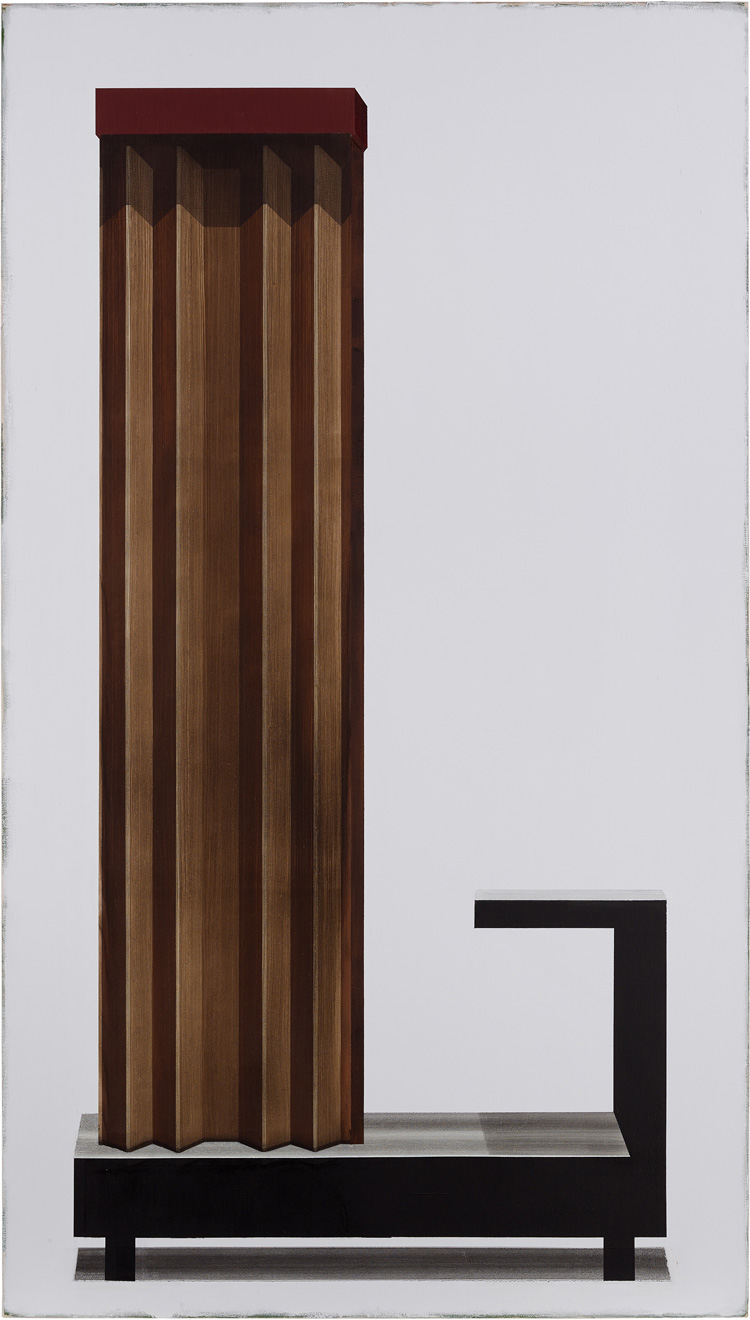
Michael Simpson. Confessional 6, 2018-19. Oil on canvas, 282 x 162 cm. Images courtesy the artist and Blain|Southern.
DT: The two confessionals in this show are virtually identical, although one is shown from a slightly higher vantage point. This idea of repetition, but with slight differences, such as a change in viewpoint, or lighting, is something you often explore.
MS: I’m really interested in the power of repetition and of variants. Egyptian painting interests me a great deal. The Egyptians, I think, were the first to really understand the power of repetition and they used it for more than two and a half thousand years. Regarding variants, at any one point during the making of a painting there is a multiplicity of different decisions to make, which may be major or minute changes. This is very meaningful to me. The most significant changes in those two confessionals are the nature of the two reds at the very top of the paintings; for me, they illuminate the work in different ways. I think it was Virginia Woolf who wrote something like there are a hundred different ways to describe a candlestick on a mantelpiece, which, of course, she was absolutely right about.
DT: Your triptych, Squint 65, appears to show the same scene repeated, but with slight variations in the shadows. Do you work from models or maquettes to get the shadows right?
MS: No. If you’re a painter you build a vocabulary of experience; the experience of shadows drawn from life, for instance, and a vocabulary of forms and so on. I decide at the outset where the light source is, and then I make the painting. But all the decisions are essentially about the structure of the painting itself and where the shadows have to fall, not in relation to the logic of time, or of a physical space, or where the sun is, but how it works within the painting. If it looks right, it is right. Painting contains its own truths and that’s the thing that counts in the end.
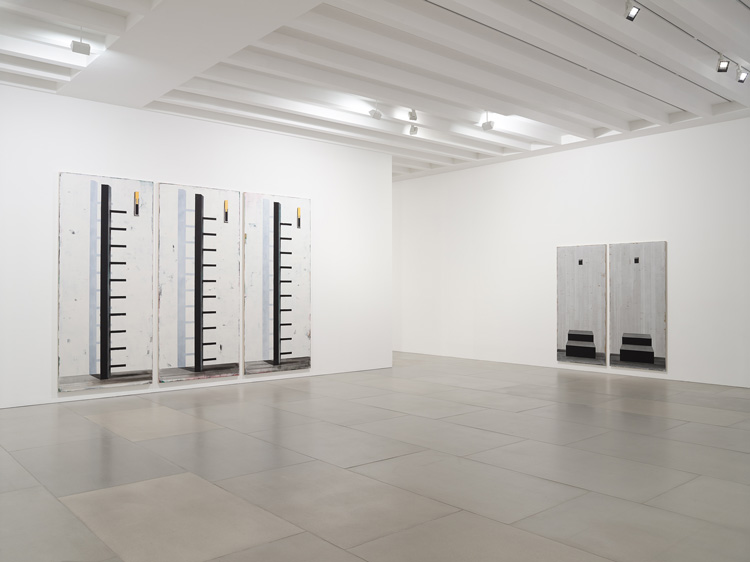
Michael Simpson, New Paintings, 2019. Installation view, Blain|Southern London. Photo: Peter Mallet.
DT: I’m sure you’ve heard numerous pronouncements regarding “the death of painting” during the course of your career and yet painting endures. What is it that keeps you painting?
MS: The wonder of it. The fact that it is the most marvellous thing with all its beautiful limitations; you basically have four boundary lines in which to make this flat surface painting and you can do anything you like with it. Painting will endure for ever, of course. It’s an instinct, a human instinct to make marks on essentially a flat surface. Although I do believe, conceptually, that in some way it does feel exhausted. With so much “so-called” art being made today, the value of the object is demeaned. But painting is still a wondrous thing, and will endure.
• Michael Simpson: New Paintings is at Blain Southern, London, until 16 November 2019. Simpson’s work is also included in Slow Painting, a Hayward Gallery Touring exhibition of contemporary British painting, at Leeds Art Gallery from 25 October 2019 to 12 January 2020 and then touring to venues across the UK.